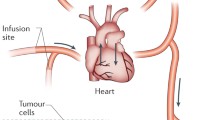Summary
Experimental data, particularly derived from tumour spheroids, indicate that drug penetration barriers may be an important determinant of cytotoxic drug efficacay, even in spheroids of only a few hundred microns in diameter. Clinically, tumour masses of this size would equate with those micrometastases which are the target of adjuvant chemotherapy in a wide range of tumour types. It is apparent, therefore, that even at this relatively early stage of the metastatic process, which ultimately proves to be fatal in many patients, measures aimed at improving drug penetration may prove to be crucial in improving the therapeutic efficacy of cytotoxic agents.
Similar content being viewed by others
References
Dalmark M, Storm HH (1981) A Fickian diffusion transport process with features of transport catalysis. J Gen Physiol 78: 349–364
Durand RE (1981) Flow cytometry studies of intracellular adriamycin in multicell spheroids in vitro. Cancer Res 41: 3495–3498
Eksborg S (1982) Intravesical installation of antineoplastic drugs. Some general aspects. Anthracyclines and Cancer Therapy, 1982, 147–157
Gal D, Ohashi M, MacDonald PC, Buchsbaum HJ, Simpson ER (1981) Low-density lipoprotein as a potential vehicle for chemotherapeutic-agents and radionuclides in the management of gynaecologic neoplasms. Am J Obstet Gynaecol 139: 877–881
Goldacre RJ, Sylven B (1962) On the access of blood-borne deys to various tumour regions. Br J Cancer 16: 306–322
Kaelin WG Jr, Shrivastar S, Shand DG, Jirtle RL (1982) Effect of verapamil on malignant tissue blood flow in SMT-2A tumor bearing rats. Cancer Res 42: 3944–3949
Kaye S, Merry S (1985) Tumour cell resistance to anthracyc-lines — a review. Cancer Chemother Pharmacol 14: 96–103
Legha SS, Benjamin RS, MacKay B, Ewer M, Wallace S, Valdivieso M, Rasmussen SL, Blumenschein GR, Freireich EJ (1982) Reduction of doxorubicin cardiotoxicity by prolonged continous intravenous infussion. Ann Intern Med 96: 133–139
Lowenstein WR (1981) Junctional intercellular communication: the cell-to-cell membrane channel. Phys Rev 61: 829–898
Mattson J, Peterson P (1981) Influence of vasoactive drugs on tumour blood flow. Anticancer Res 1: 59–61
Nederman T, Carlsson J, Malmquist M (1981) Penetration of substances into tumour tissue. A methodological study on cellular spheroids. In Vitro 17: 290–298
Paul C, Gahrton G, Peterson C (1982) Effects of DNA-binding and prolonged infusion on the pharmacokinetics of anthracyclines. Anthracyclines and Cancer Therapy 1982: 18–25
Papadimitriou JM, Woods AE (1974) Structural and functional characteristics of the microcirculation in neoplasms. J Pathol 116: 65–79
Plumb J, Kerr DJ, Wilmott N, Burt AD, More IAR, Kaye SB (1985) Fluorescent microscopic studies on the differential cellular distribution of adriamycin and 4′-deoxydoxorubicin. BACR Abstract 4: 9, Winter Meeting
Powis G (1985) Anticancer drug pharmacodynamics. Cancer Chemother Parmacol 14: 177–183
Sutherland RM, Eddy HA, Bareham B, Reich K, Vanantwerp D (1979) Resistance to adriamycin in multicellular spheroids. Int J Radiat Oncol Biol Phys 5: 1225–1230
Vaupel PW, Frinck S, Bicher HI (1981) Heterogeneous oxygen partial pressure and pH distributionin 3H-mouse mammary adenocarcinoma. Cancer Res 41: 2008–2013
Weinstein RS, Merk FB, Alroy J (1976) The structure and function of intercellular junctions in cancer. In: Klein G, Weinhouse S (eds) Advances in cancer research. Academic, New York, pp 23–84
West GW, Weichselbaum R, Little JB (1980) Limited penetration of methotrexate into human osteosarcoma spheroids as a proposed model for solid tumour resistance to adjuvant chemotherapy. Cancer Res 40: 3665–3668
Wibe E (1980) Resistance to vincristine of human cells grown as multicellular spheroids. Br J Cancer 42: 937–941
Wilson WR, Whitmore GF, Hill RP (1981) Activity of 4′-(9-acridinylamino) methanesulfon-m-anisidide against Chinese hamster cells in multicellular spheroids. Cancer Res 41: 2817–2822
Author information
Authors and Affiliations
Additional information
This work was supported by the Cancer Research Campaign
Rights and permissions
About this article
Cite this article
Kerr, D.J., Kaye, S.B. Aspects of cytotoxic drug penetration, with particular reference to anthracyclines. Cancer Chemother. Pharmacol. 19, 1–5 (1987). https://doi.org/10.1007/BF00296245
Received:
Accepted:
Issue Date:
DOI: https://doi.org/10.1007/BF00296245




